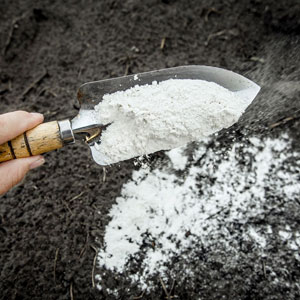Lime comes in three forms: pulverized, which is a fast-acting powder recommended for the garden; granular, which is sugar-textured and dust-free; and pelletized, which is fast-acting and dust free. Granular and pelletized forms can be applied to the lawn with a drop or rotary spreader. Application rates for the different types of soil are listed right on the back of the product bag. Generally, fifty pounds of lime per thousand square feet will raise the pH ½ of a point.
How do soils become acidic? Over the years, calcium and magnesium, the alkaline components in the soil, become replaced by hydrogen and are lost in drainage water. Also, while nitrogen is essential for good growth of grass, heavy applications make the soil more acidic. Not only does lime correct the acidity of the soil by reducing the toxic amounts of aluminum, manganese and iron, but it also supplies calcium and magnesium, which are essential for plant growth. Other benefits of applying lime include less leaching of potassium, making phosphorus more available and speeding the decomposition of organic matter in the soil for reuse by the plant.
How can you find out if your soil is too acidic? Bring in a soil sample, ½ cup taken from a depth of 6 inches, for a free pH test or, for a complete analysis of your soil, contact your county agent for a Soil Test Kit.






